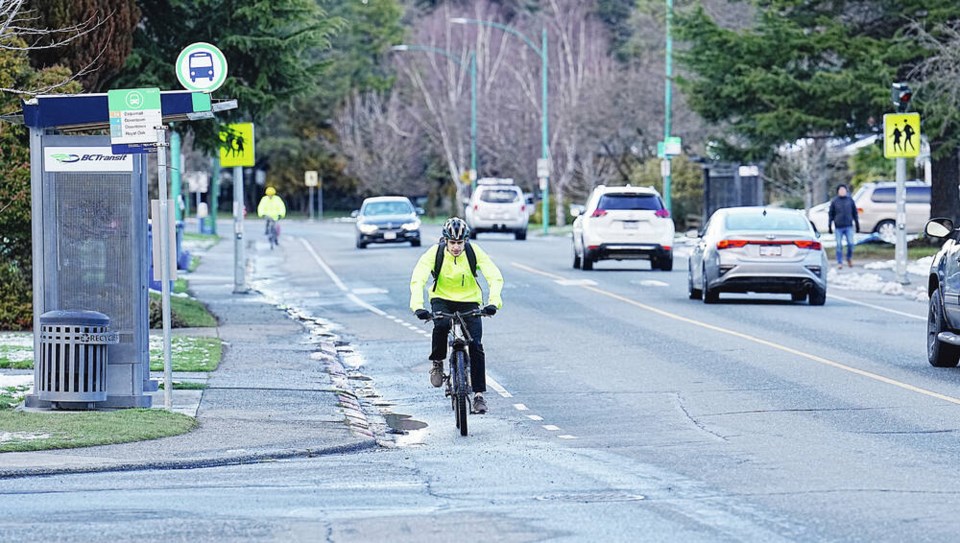I received a ton of feedback on my column about the changes we’re facing under the sa╣·╝╩┤½├Į’s amendments to our Motor Vehicle Act in Bill 23. A lot of the feedback however was not about the column itself, but about the photo which accompanied it.
The photo showed a cyclist cruising along in a Fort Street bike lane, helmetless, and with headphones mounted in both ears.
The comments followed the same thread. It’s nice to think about protecting “vulnerable road users” as Bill 23 envisions, but aren’t we all ultimately paying a cost for cyclists who are actually making themselves more vulnerable? Tough to argue — almost.
Ignoring the lack of helmet for the moment, the problem was I could find no definitive study which shows that cycling with headphones on is patently more dangerous than being “open eared.”
That surprised me because intuitively .. When driving, I’ve often been ready to pull out from the curb or leave a stop sign but didn’t because I heard a vehicle approaching.
Our laws make cyclists bear the same rights and responsibilities as drivers yet we don’t ban deaf people from driving. We also don’t limit the amount of sound being blasted from inside cars via the “boom box” (if that’s still what they’re called these days), although we probably should. If your back licence plate is vibrating from sound waves — it’s too loud.
Some cycling advocates tout studies which indicate the loss of hearing enhances other senses, making them more aware when they ride. They also point to evidence which shows that playing music instills more calm in a rider, filtering surrounding distractions and allowing for more focus on the task of cycling itself.
I’m not sure I buy those ideas, yet an Australian study quoted by Joseph Stromberg in Vox showed that a person wearing iPod earbuds turned all the way up to the maximum 87 decibels could still hear another cyclist’s bell from a distance of 32 feet. Another user inside a car with the sound at only 69 decibels couldn’t hear the same bell.
Some cycling advocates point to new tech such as helmets with built in speakers and thanks to their Bluetooth connectivity, allow cyclists to talk to each other at distance. There are also bone conduction earphones which allow the ear canal to remain unobstructed yet allow for the wearer to clearly hear those tunes.
All this might sound like I’m defending the picture which accompanied my column a couple weeks ago. I’m not, though I do think pedestrians with headphones are actually a bigger problem.
Even though I couldn’t find a clear study that showed that cycling with headphones is inherently bad, I don’t agree with wearing them when riding. Admittedly, I haven’t cycled in years, but when I did I wanted to have all the sensory information I could get. Being able to brake, swerve or veer away, even if there’s only a millisecond warning, is worth it to me.
Under sa╣·╝╩┤½├Į law, cyclists have a duty to ride with reasonable consideration for others as well as cycle with due care and attention — just like motorists. And while every crash scenario is different, it might be very tough to argue later on that you were cycling reasonably or with due care and attention in a crash when you intentionally deprived yourself of that vital sense of hearing.
It’s also important to remember no matter what may cause a cycle versus vehicle collision — the cyclist is always the loser.
Glove Box: Still on the cycling theme, a reader asked if it was legal to park in a bike lane. In some areas it should be obvious. If you have to drive over a curb to get into a lane where all four tires are pushed up against concrete on both sides of your car, then you probably weren’t meant to park there.
Admittedly though for some bike lane configurations it’s a little grey. I’ve seen areas where there’s definitely double white solid lines intended for bike use but there’s also enough space on either side of those lines which could fit a parked vehicle. A lack of explanatory signage can also be a problem.
A bike lane, marked as such, is a “designated use lane” in sa╣·╝╩┤½├Į That means you can’t drive, operate, stand or park a vehicle there unless specifically allowed by ministerial regulation, or via a local by-law and proper signage explaining why you are allowed to be there.



